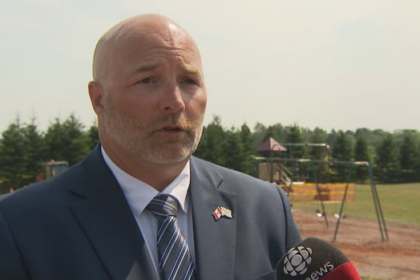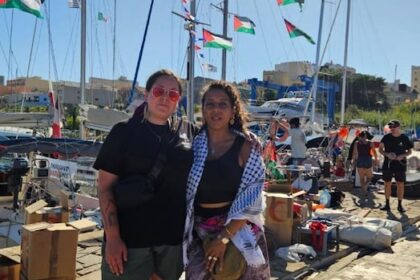This is part three of a three-part series from Radio-Canada about the 50th anniversary of the James Bay and Northern Quebec Agreement. Find part one here and part two here. The community of Chisasibi, the largest of the Cree communities in Eeyou Itschee, is in full expansion, and the number of new buildings is immediately noticeable. Rapid population growth has led to the construction of several new residential areas — nearly two-thirds of Chisasibi’s population is under 35. Walking through the streets, the sounds of kids playing baseball blend into the buzzing of ATVs. Chisasibi has grown out of the relocated community of Fort George on the banks of the La Grande River. (Félix Lebel/Radio-Canada)Many houses have a teepee, or mitchuap, in their backyard, used to cook geese and other traditional foods over a wood fire — a sign of wanting to keep the culture alive.Other large projects are underway, including the construction of a hospital and an elders’ centre.Many homes in Chisasibi have a mitchuap (Cree for teepee) in their yards, a sign the community is still rooted in its traditional culture. (Félix Lebel/Radio-Canada)Darius Neacappo Pelchat is one example of local residents leading the development of their community. For the past two years, the 25-year-old has owned a mechanic shop with about 10 employees, and the regular appointments are proof of a healthy business. Born and raised in Chisasibi, Neacappo Pelchat has become a role model for much of the younger generation, so much so that he was recently elected as deputy grand chief of the Cree Nation Youth Council. Darius Neacappo Pelchat says he’s returned to Chisasibi to serve his community. (Félix Lebel/Radio-Canada)The council represents the interests of young people at various political tables in the region and also organizes support programs. In between two appointments at the shop, Neacappo Pelchat takes the time to meet with a young man that’s hoping to receive financial support from the council. He looks over the man’s business plan and promises to get back to him soon. It’s a position Neacappo Pelchat has also found himself in: leaning on his community for a loan to be able to start his business. Darius Neacappo Pelchat wants as many young people as possible to be able to get the help they need to get ahead. (Félix Lebel/Radio-Canada)To him, these economic development opportunities are a direct legacy of the James Bay and Northern Quebec Agreement (JBNQA) signed 50 years ago.Though that was not always the case. “For 25 years after the signature of the James Bay and Northern Quebec Agreement in 1975, many disputes arose between the Cree and Quebec and Canada, due largely to failure to carry out treaty commitments,” reads the website of the Grand Council of the Crees. That led to the signing of a “new relationship agreement” signed by the parties in 2002, commonly known as the “Paix des Braves. That agreement stipulates that the Cree receive an additional $70 million annually for 50 years. “We’re so fortunate because we have so many different entities that started from the JBNQA,” says Neacappo Pelchat. He benefitted from these “entities” firsthand after receiving financial support to attend Algonquin College and Carleton University in Ottawa from the Cree School Board. The board, he says, helps ensure that “we have the education to bring back home and to be able to help our communities grow bigger and stronger, and make sure that we continue as individuals and as a nation.”Chisasibi Secondary School was built in 2023. The Eeyou Istchee College of Science and Technology also opened earlier this year. (Félix Lebel/Radio-Canada)Still, he recognizes his community faces many challenges, but believes the current situation is better than what could have been. “If it wasn’t for the agreements, we would have had nothing,” he says. “They would have still went ahead with their project because they had more power.” Chisasibi sits on the banks of the La Grande River in Northern Quebec. (Courtesy of Jimmy Sam)A different perspectiveThe community of Kuujjuaq is about 800 kilometres north-east of Chisasibi as the crow flies. Flying to Nunavik, above the 55th parallel, it’s easy to see the stark delineation of boreal forest and tundra. Kuujjuaq sits on this forested frontier; with its 3,000 residents, it is the region’s largest community. The community of 3,000 people is the largest in Nunavik. (Eilís Quinn/Radio-Canada)Driving through the community, one could argue that it hasn’t benefited from the same economic windfall from the JBNQA. Most public buildings show their age, and water delivery trucks often can’t meet the demand, so residents have to go without. The ongoing housing shortage is also hitting community members hard, with nearly half living in overcrowded apartments.Despite this reality, a young generation of Inuit is motivated to tackle these systemic inequalities. Kuujjuaq is the regional hub for Nunavik, with the head offices of several public institutions, like the Kativik school board and the Nunavik Regional Board of Health and Social Services. (Félix Lebel/Radio-Canada)Among them is Janice Parsons. She’s known throughout the region as a proud representative of Inuit culture, and especially for her throat singing with her partner and fiancé, Sandy Emudluk. Parsons is also the president of the Qarjuit Youth Council, an organization that represents Nunavik’s youth and encourages them to become active in their communities. Janice Parsons has lived her whole life in Kuujjuaq. (Félix Lebel/Radio-Canada)One of the ways it does so is by organizing treaty negotiation simulations, where participants are divided into teams and must negotiate on a specific issue, while defending the interests of Nunavimmiut.Parsons says these simulations show youth the complexities of negotiating and give them a better understanding of real treaties, such as the JBNQA. Qarjuit’s organizes treaty simulations as a way to get youth engaged in politics. (Félix Lebel/Radio-Canada)“They get to discover leaders that were put in this position to advocate on behalf of the whole Nunavik region in a short amount of time,” she says, adding that negotiators at the time “had no choice” but to step up. “Otherwise our land will be stolen. Everything will be taken from us.”Parsons says the simulations are also important for possibly renegotiating the JBNQA in the future, as many believe the promises of the agreement were never completely fulfilled. In Nunavik, nearly 80 per cent of high school students drop out. (Félix Lebel/Radio-Canada)When it comes to the education and health care systems, which were both included in the JBNQA, she says many youth feel like they’re only getting the “bare minimum”. To her, the region’s low graduation rate — nearly 80 per cent of Nunavik youth drop out of high school — proves the underfunding of education. A constant teacher shortage only exacerbates the problem, she adds. It’s setting them up for failure. Graduating high school and going to college or university in the South, they’re overwhelmed with the work that they’re given.- Janice ParsonsParsons also points to the health-care system as being inadequate. Soon she’ll have to go through that system herself when she’ll travel south more than 1,400 kilometres to Montreal to give birth. The trip must happen weeks ahead of her due date, so she’ll likely be waiting for those first contractions from a hotel room, far from the rest of her family. The region’s health-care facilities don’t have access to specialist physicians, and despite the dedication of local midwives, going to Montreal is generally considered the safer option. Kujjuaq’s Ungava Tulattavik Health Centre does not have specialized medical services. (Félix Lebel/Radio-Canada)These kinds of inequalities, she says, are what motivate her work. “As youth it makes us angry,” she says. “Angry because we want a good future. We want a future where we could succeed, see ourselves succeed and become great leaders.” But for now, she adds, youth feel like they’re “stuck waiting” for basic necessities. “It seems like a long way to get there.”A new round of negotiationsWhen entering the Makivvik Corporation’s offices, visitors are met with a huge map showing the traditional Inuit names of lakes, rivers, mountains, and valleys in the region.Pita Aatami, Makivvik’s president, is proud of the map. To him, it shows the continued connection Inuit have to the land, despite having ceded parts of it to the Quebec government 50 years ago through the JBNQA. Aatami says those negotiations put Inuit in an unwinnable position at the time.To Pita Aatami, Makivvik’s president, this detailed map of Inuit place names counters the idea that Northern Quebec is a barren wasteland. (Félix Lebel/Radio-Canada)“They were forced into negotiation using the laws of the non-Native people that they never dealt with before in their lives,” he says. “ Inuit were, and it’s sad to say, but they were already [disadvantaged] in terms of how they were going to negotiate, because it should have been on an equal basis, which it wasn’t.” While he acknowledges the agreement has led to some economic development in the region — Makivvik itself was created to administer the funds (about $90 million) Inuit received through the JBNQA — he still believes public services are not serving Nunavimmiut as well as they should. Kuujjuaq is about 1,400 kilometres north of Montreal as the crow flies. The community sits where taiga transitions to tundra. (Félix Lebel/Radio-Canada)In an attempt to improve the situation, Makivvik launched a self-government negotiating process nearly two years ago with the Quebec government. “We want to take back control of Nunavik,” says Aatami. “I’m always telling people that this land was stolen by governments from the Inuit […] they were forced to give up their lands.” Although many regional institutions are managed locally, they depend on funding allocated by the provincial government. But to Aatami, that funding has long been insufficient. He points to the recent water crisis in Puvirnituq as an example. Residents went weeks without running water last winter. Aatami echoed the opinion shared by many that the situation was caused by a lack of investment in infrastructure for remote communities. As Makivvik president, Pita Aatami is working toward Nunavik one day becoming a self-governed region. (Félix Lebel/Radio-Canada)Still, so far he says he’s optimistic about self-government negotiations. “We do this together,” he says. “Whatever happens in the region is done in partnership. That’s my dream.”
Wednesday, 12 Nov 2025
Canada – The Illusion
Search
Have an existing account?
Sign In
© 2022 Foxiz News Network. Ruby Design Company. All Rights Reserved.
You May also Like
- More News:
- history
- Standing Bear Network
- John Gonzalez
- ᐊᔭᐦᑊ ayahp — It happened
- Creation
- Beneath the Water
- Olympic gold medal
- Jim Thorpe
- type O blood
- the bringer of life
- Raven
- Wás’agi
- NoiseCat
- 'Sugarcane'
- The rivers still sing
- ᑲᓂᐸᐏᐟ ᒪᐢᑿ
- ᐅᑳᐤ okâw — We remember
- ᐊᓂᓈᐯᐃᐧᐣ aninâpêwin — Truth
- This is what it means to be human.
- Nokoma












